






Back pain is one of the most common reasons people seek medical care across age groups and lifestyles. It can range from dull aches to severe discomfort, limiting daily activities. It can be broadly categorized into upper, middle, and lower back pain, based on the region involved. Among these, lower back pain (LBP) is the most prevalent.
The lower back refers to the area of the spine just below the ribcage. It includes the vertebrae, intervertebral discs, and surrounding muscles and ligaments that support your spine and allow movement.
Pain is your body’s way of signaling that something isn’t right. Ignoring it may lead to worsened symptoms, loss of function, or more complex health issues down the line.
Back pain can be:
Sudden and short-term, often caused by injury, strain, or poor posture
Persisting longer than 12 weeks, often due to underlying issues such as disc prolapse, age-related spinal degeneration, arthritis, poor posture or sedentary lifestyle habits, and sometimes even systemic conditions like osteoporosis.
Pain is complex with multiple underlying causes. Each of the causes must be diagnosed and treated for effective and lasting relief. At its core, the pain relief journey unfolds in three distinct stages:
Relieving pain and discomfort through physical treatments (like heat therapy), pharmacological interventions (anti-inflammatory medications or muscle relaxants), and non-surgical procedures like nerve blocks, epidural injections, or radiofrequency ablation, all aimed at targeting the source of pain.
Rebuilding spinal support through guided exercises and rehabilitation, and non-surgical procedures such as platelet-rich plasma (PRP) therapy that may support tissue healing and improve muscle or ligament strength.
Helping you return to regular activity, pain-free.
Many people struggle with back pain because they receive fragmented care, addressing symptoms but not the root cause. Effective treatment needs a coordinated, multidisciplinary approach. Skipping any of these stages increases the risk of recurrence or incomplete healing.
At Nivaan, we specialize in helping individuals find lasting relief through a multidisciplinary, tech-enabled integrated care model. Nivaan’s holistic approach offers end-to-end pain management services based on these key pillars:
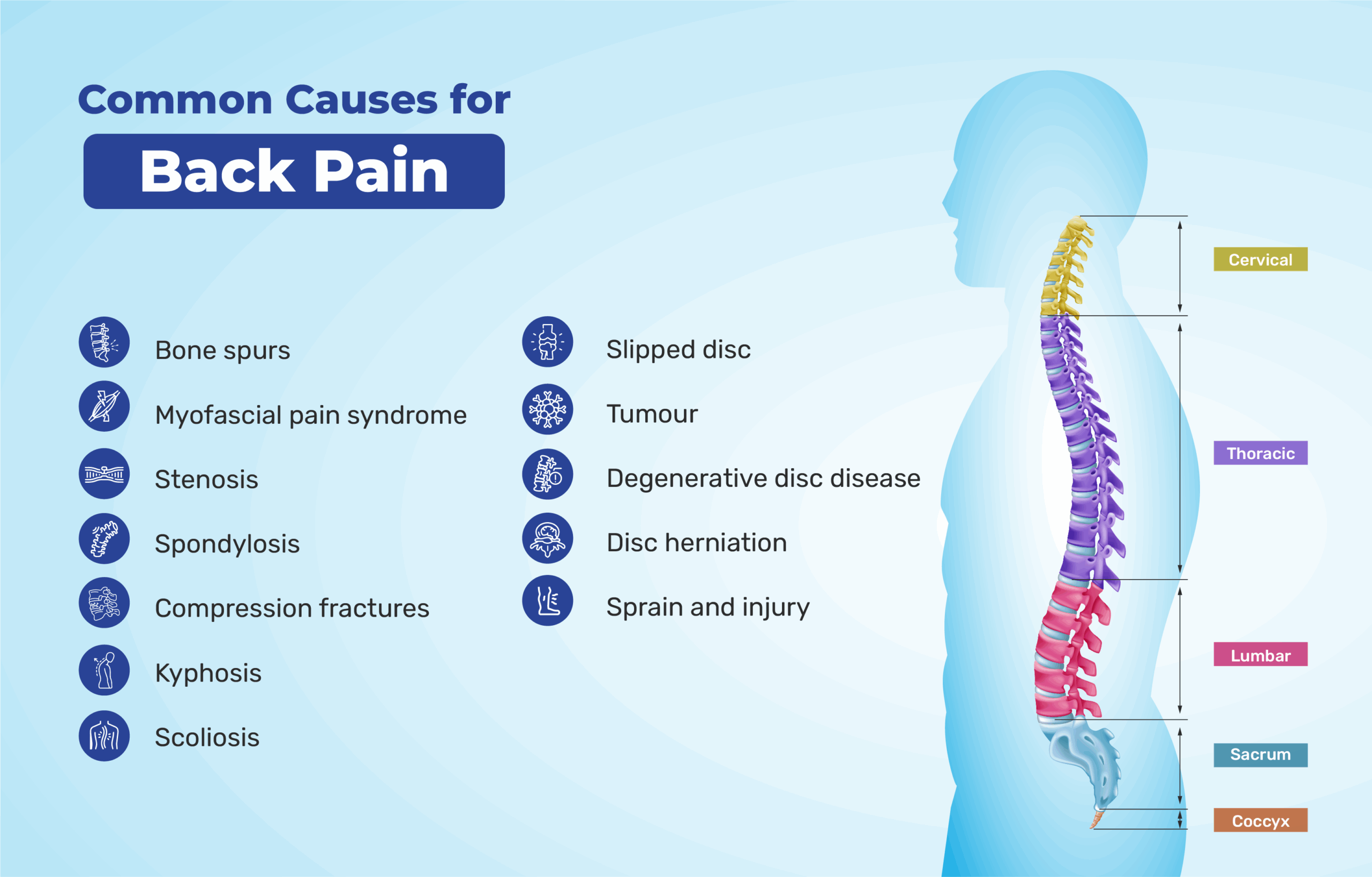
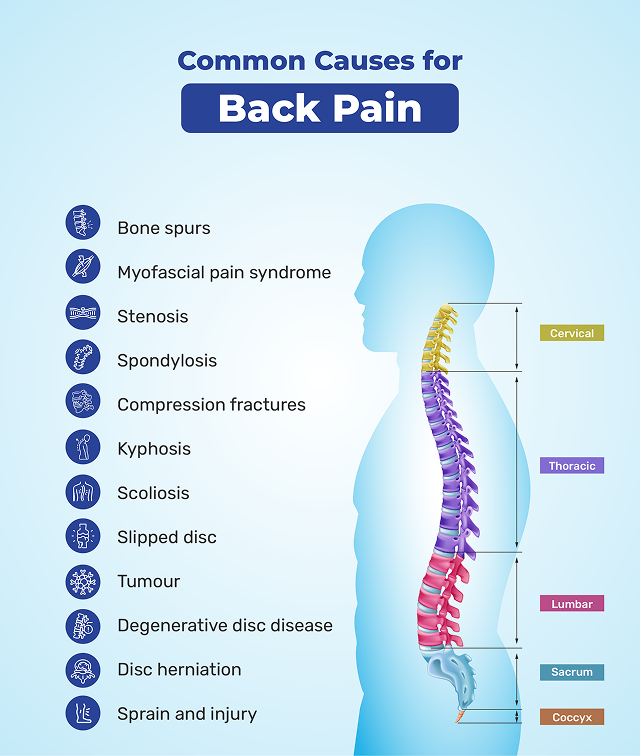
When you visit Nivaan with back pain, one of the first things our experts assess is when your symptoms began because the onset and duration of pain offer important diagnostic clues.
If there are no red flag symptoms (like unexplained weight loss, fever, or pain that worsens at night), the most common culprit is a muscle strain or ligament sprain that may have been caused by physical triggers such as:
These conditions usually respond well to rest, hot fomentation, pain relief medications, physiotherapy, and back muscle strengthening.
Chronic lower back pain requires deeper evaluation.
Facet Joint Arthropathy: As the discs between vertebrae wear down, more pressure shifts to the facet joints. Over time, these joints can become arthritic or inflamed, especially with repeated twisting or lifting.
Sacroiliac (SI) Joint Dysfunction: The SI joints connect the spine to the pelvis. The joint surfaces can shift out of position or become locked, causing pain and associated muscle dysfunction.
Reformists Syndrome: This occurs when the piriformis muscle spasms or becomes tight, irritating, or compressing the nearby sciatic nerve, leading to pain. It’s commonly mistaken for sciatica.
Spinal Stenosis: The narrowing of the spinal canal or the openings where spinal nerves exit can pressure the spinal cord or nerve roots, often causing pain, numbness, or weakness in the back, neck, or limbs, depending on the affected area.
2. Sometimes, lower back pain has less to do with the spine and more to do with underlying medical conditions, especially in cases where conservative treatments haven’t helped. Our experts also check for:
At Nivaan, we are dedicated to helping individuals overcome lower back pain and return to active, fulfilling lives. Our multidisciplinary, tech-enabled integrated care model brings together clinical expertise and personalized care to address not just the symptoms, but the root causes of pain. Understanding that pain is influenced by physical, psychological, and lifestyle factors, we offer an end-to-end, holistic approach to pain management.
Our team includes some of the most experienced pain physicians, physiotherapists, nutritionists, and psychologists who work collaboratively to design a single, customized care pathway for each patient.
While anyone can experience lower back pain, certain factors can increase your risk:
Prolonged sitting, slouching, or improper lifting techniques.
Jobs that involve heavy lifting, prolonged sitting, or repetitive bending can strain the back.
Lack of exercise, being overweight, and smoking can contribute to back pain.
As we age, wear and tear on the spine can increase our susceptibility to back pain. Disc degeneration is more common in younger patients, while facet joint and sacroiliac joint pain are more common in older patients.
If you’ve had back pain, you’ll likely experience it again.
Some conditions that cause back pain, like ankylosing spondylitis, have a genetic component.
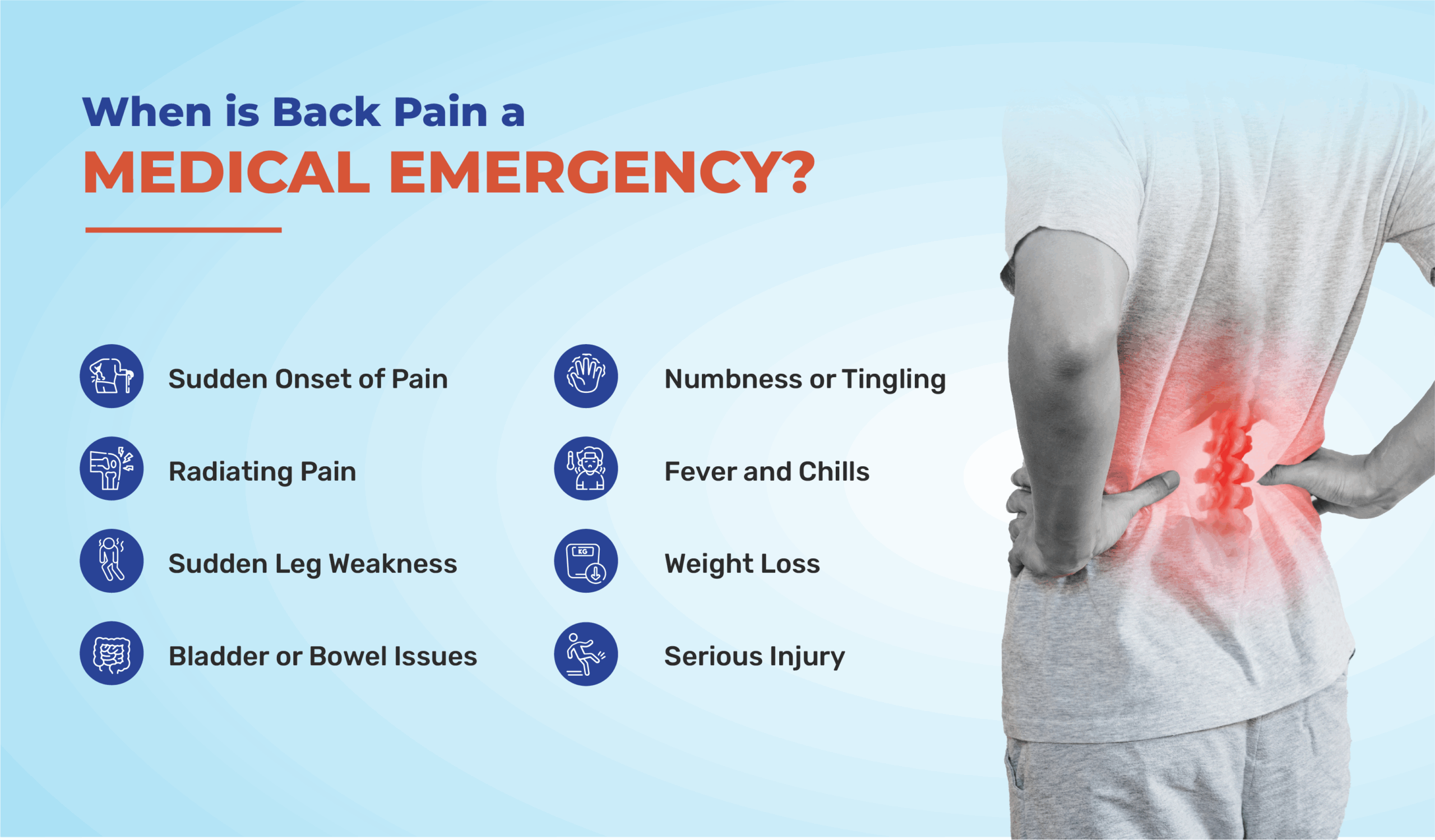
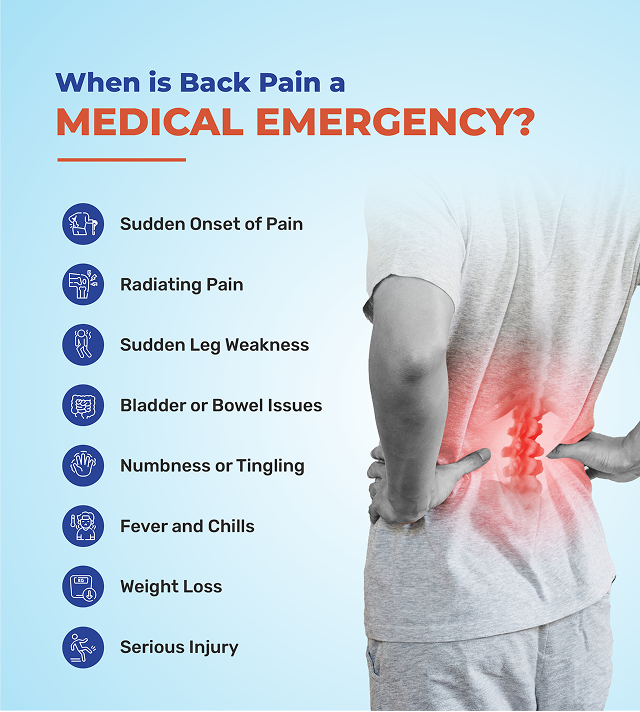
Certain symptoms signal a potentially serious underlying condition that requires immediate medical attention. These are known as ‘Red Flags’.
Seek urgent care if you experience:
Sudden onset pain, especially if you’re over 55 or under 20. This can indicate some serious underlying problem that should be investigated.
A pain that radiates to other areas may indicate a nerve compression.
Back pain accompanied by weakness in the legs may be due to conditions like sciatica and spinal stenosis. Also, sudden leg weakness can be a sign of stroke, so don’t take this condition lightly.
Intense back pain with loss of control over your bladder or bowels indicates nerve damage (Cauda Equina Syndrome) or a spine infection.
This may be due to a nerve or spine condition that needs immediate medical attention.
It may indicate infection
Which is unexpected and sudden in onset
Specially after a fall or accident
From the moment you step into Nivaan, our multidisciplinary team will conduct a complete evaluation and work together to identify the root cause of your pain. Then, a personalized treatment plan tailored to your needs and goals is built. We begin with a comprehensive evaluation with:
We start by listening. Our specialists will ask about:
We’ll assess your posture, flexibility, strength, reflexes, and nerve function. A range of clinical tests helps us pinpoint the area and nature of the problem
If your symptoms are complex or don’t improve, we may recommend imaging to get a clearer picture:
Other tests– Such as EMG/NCV studies, ultrasound, bone scans, or diagnostic injections to clarify complex cases
By combining clinical expertise with advanced diagnostics, Nivaan ensures a precise, accurate diagnosis that drives smarter, safer, and more effective treatments.
At Nivaan, we believe in a patient-centered approach, with treatment plans tailored to your specific condition and needs. Led by a pain specialist, our clinical team has specialists in physiotherapy, psychology, and nutrition.
Guided by multidisciplinary and tech-enabled protocols that are gold standard worldwide, our experts design a personalized, protocol-based treatment plan focusing on end-to-end pain management.
These plans aim to relieve pain and inflammation, improve mobility and function, and help you return to your daily activities by effectively reversing the underlying disease process
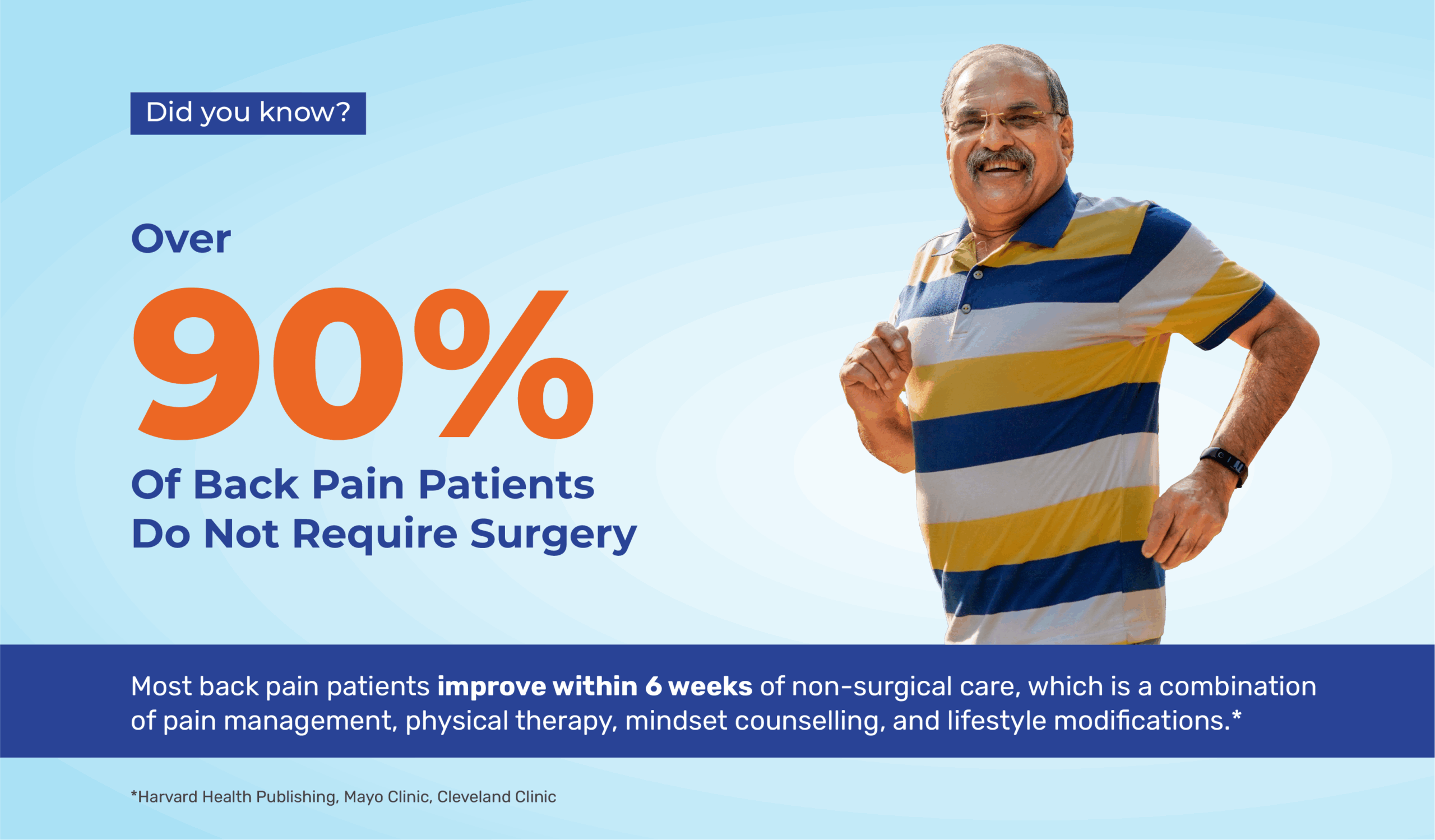
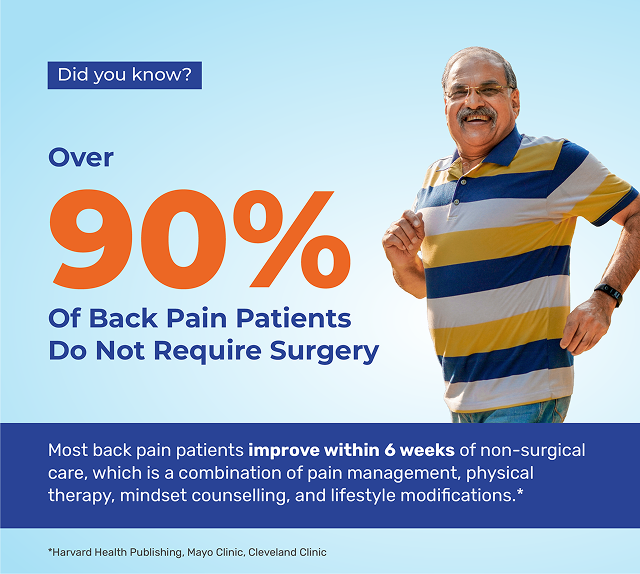
Our comprehensive approach includes:
Done via non-surgical treatments, interventional spine procedures, and medications.
Guided by our expertise, patients learn to increase muscle strength, movement, flexibility, and endurance. Physiotherapists help patients learn about proper spine alignment and approaches to move safely while teaching ways to improve strength, posture, and flexibility.
We’ll guide you on modifying your diet and lifestyle to avoid aggravating pain and promote healing. Here are some practical tips to help you:
It addresses not only the physical aspects of discomfort but also the emotional and psychological factors contributing to pain perception and management. This includes:
For persistent pain that doesn’t respond to conservative treatments, we offer a range of minimally invasive procedures:
Radio Frequency Ablation (RFA) is a same-day procedure performed under light sedation or anesthesia, that uses heat to disrupt nerve signals responsible for chronic pain. The doctor first performs a nerve block to determine the exact source of the pain. A needle is then inserted to target the nerve causing the pain, and heat is applied. This heat creates a lesion that blocks pain signals arising from your spine that travel along the affected nerve to the brain.
Regenerative therapies such as Platelet Rich Plasma (PRP), Bone Marrow Aspirate, and other autologous biologics stimulate the body’s natural healing process. They work by promoting tissue repair in damaged discs, ligaments, tendons, and joints. These treatments aim to reduce inflammation, restore mobility, and improve long-term spinal health. They are especially useful for patients seeking to heal underlying damage rather than only manage symptoms.
Epidural Steroid Injections involves injecting a corticosteroid medication directly into the epidural space surrounding the spinal nerves. By reducing inflammation around irritated nerves, it provides relief from chronic lower back pain and sciatica. Pain reduction may occur immediately or develop gradually over days, with results lasting several weeks to months. These injections are often used to help patients return to physiotherapy and normal activities with greater ease.
This procedure is typically recommended for patients who continue to experience pain after spine surgery. Scar tissue (adhesions) may compress or irritate nerves, leading to persistent back pain. During adhesiolysis, medication and special solutions are delivered into the epidural space to break down this scar tissue and free trapped nerves. By restoring nerve mobility, the treatment can significantly reduce pain and improve quality of life.
Facet joints, located at the back of the spine, are a common source of chronic back pain due to arthritis or injury. In this procedure, an anesthetic and anti-inflammatory medication are injected directly into the affected joints. This not only helps confirm the diagnosis of facet joint pain but also provides targeted relief. Patients often experience reduced stiffness, improved range of motion, and better participation in daily activities.
The sacroiliac joints connect the spine to the pelvis and can become inflamed due to injury, arthritis, or mechanical stress. SI joint injections deliver numbing and anti-inflammatory medication into the joint to reduce pain and swelling. This targeted approach helps improve mobility in the lower back and hips, making it easier to stand, walk, and perform routine tasks without discomfort.
Nerve blocks involve injecting a local anesthetic, sometimes combined with a steroid, near a specific nerve or group of nerves causing pain. By temporarily interrupting pain signals, this treatment provides both immediate relief and diagnostic insight into the pain source. In some cases, repeated nerve blocks may also help in planning more permanent interventions like radiofrequency ablation.
Trigger points are tight knots of muscle fibers that can form after injury or due to chronic strain, often causing referred pain in the back. In this procedure, a small amount of anesthetic or saline is injected into the trigger point to relax the muscle. This reduces pain, improves circulation, and restores flexibility, making it highly effective for myofascial pain syndromes.
These are minimally invasive procedures used to treat painful vertebral compression fractures, often caused by osteoporosis. In vertebroplasty, bone cement is injected into the fractured vertebra to stabilize it, while kyphoplasty also uses a small balloon to restore height before cement placement. Both treatments reduce fracture-related pain, improve spinal alignment, and help patients return to normal movement more quickly.
When back pain originates from damaged or degenerated intervertebral discs, specialized procedures are performed. These include Biacuplasty, Annuloplasty, and Intra-Discal injections, which target the disc directly to reduce inflammation and repair tissue. By addressing the root cause of disc-related pain, these treatments can significantly improve function and reduce dependency on pain medications.
Many patients have found significant to complete relief from chronic back pain through Nivaan’s multidisciplinary pain management approach:
See a doctor if your pain is severe, doesn’t improve with home treatment, radiates down your leg, or is accompanied by numbness, weakness, or bowel/bladder problems.
Sciatica is a type of pain that radiates along the sciatic nerve, which runs from your lower back down the back of your leg. It is often caused by compression of the nerve in the spine.
Most people with lower back pain do not need surgery. Surgery is typically reserved for cases where non-surgical treatments have failed or there are serious underlying conditions.
Non-surgical treatment options for lower back pain include physiotherapy to strengthen core muscles, pain-relieving medications, and targeted interventions like nerve blocks or epidural steroid injections to reduce inflammation. Advanced techniques like Radiofrequency Ablation (RFA) and Regenerative Medicine may also be highly effective. Other supportive measures include nutrition, lifestyle modifications, and pain counseling to enhance recovery. Together, these approaches aim to reduce pain, restore function, and help patients avoid or delay surgery.
You can relieve lower back pain quickly through rest, applying ice or heat, taking pain medication, and doing gentle stretches.
Acute lower back pain can last for a few days to weeks, while chronic lower back pain lasts for more than three months.
Low-impact aerobic exercise, such as walking, swimming, or cycling, can help improve blood flow and strengthen muscles in your back without putting too much strain on your spine.
Sleeping on your side with a pillow between your knees can help align your spine and reduce pressure on your lower back.
Back pain can be caused by muscle strain, herniated discs, poor posture, arthritis, sciatica, or injuries. Lifestyle factors, such as obesity and sedentary habits, can also contribute.
Yes, back pain can often be prevented by maintaining good posture, staying active, lifting objects properly, and managing stress effectively. Regular exercise and ergonomic adjustments can also help.
Factors like stress, low mood, anxiety, depression, anger, financial worries, job dissatisfaction, or family pressures can all worsen your experience of back pain. That’s why it’s important to address both the emotional and physical aspects of pain.
You can schedule a consultation by calling us at +91 90 7005 7005, visiting our website at https://www.nivaancare.com/, or filling out our online contact form at https://www.nivaancare.com/next/request-appointment. Our team will guide you through the process.
Aspect
Nivaan
Traditional Treatment
Approach
Root-cause focused, long-term recovery
Symptom-based, short-term relief
Care Team
Multidisciplinary team of pain specialists, physiologists, psychologists, and nutritionists
Single-specialist with minimal collaboration
Treatment Style
Non-surgical, personalized care with custom care plans
Often surgery-led, one-size-fits-all protocols
Mind-Body Connection
Includes dietary, mindset, and lifestyle coaching
Includes dietary, mindset, and lifestyle coaching rarely addresses emotional or psychological factors
Follow-up and Support
Continuous progress tracking and adjustments
Limited or no ongoing support
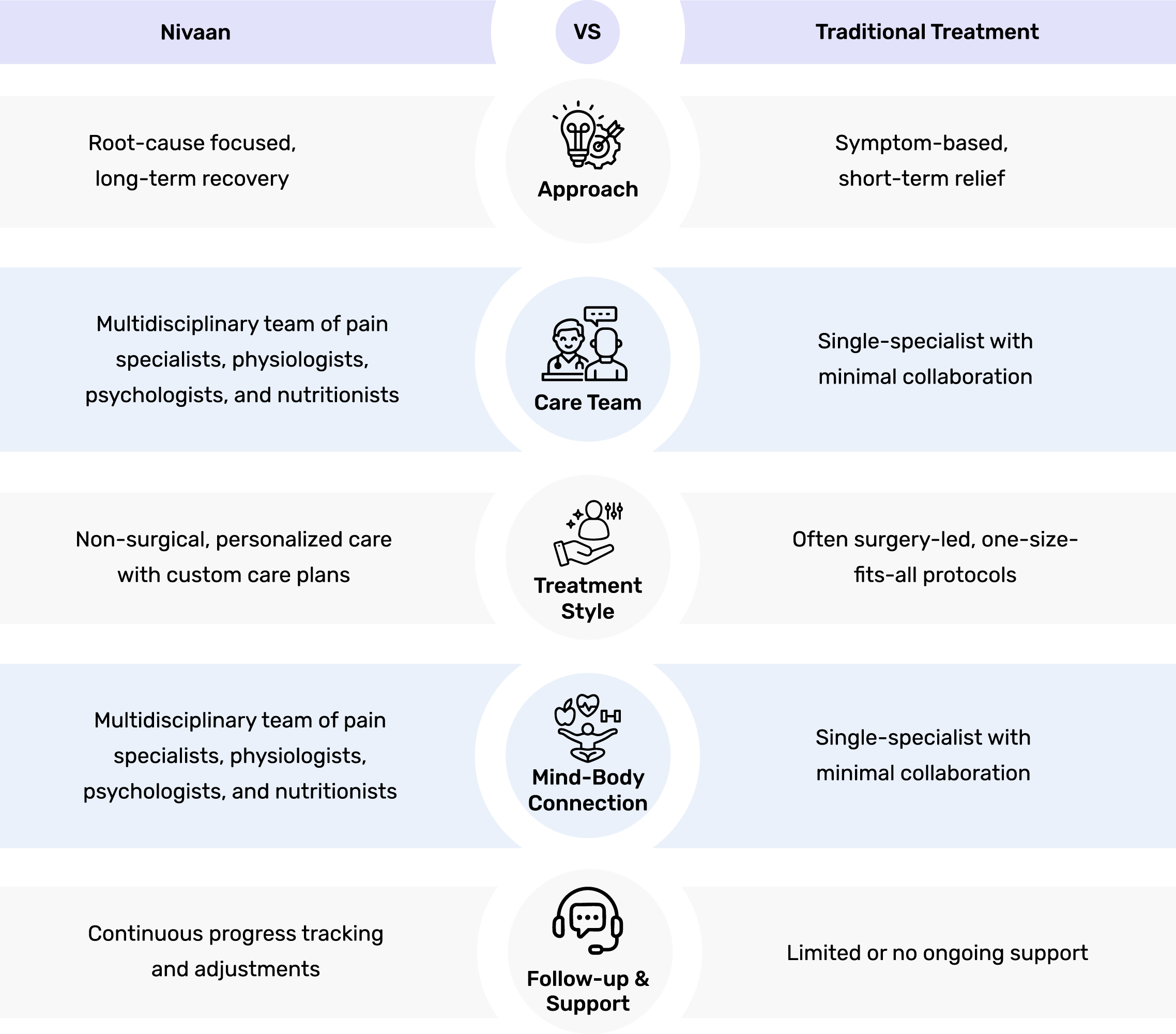
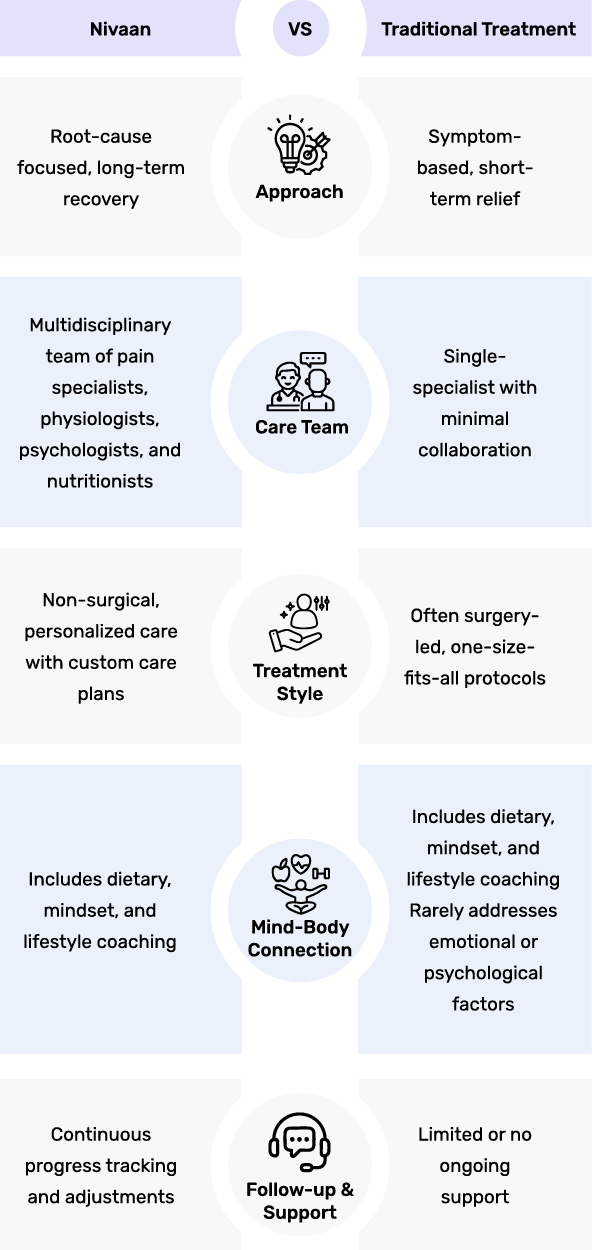

The pain specialists are
dedicatedly trained to help
treat your pain – they understand, evaluate and treat your pain’s root cause. Our doctors are trained to improve the quality of your life through medications, rehabilitative therapy, pain relief
interventions, and counseling.

Understanding your pain is the first step towards getting rid of it. Our emotional counsellors will guide you and equip you with tools to manage your pain. They will support you to make meaningful changes in your daily lifestyle.
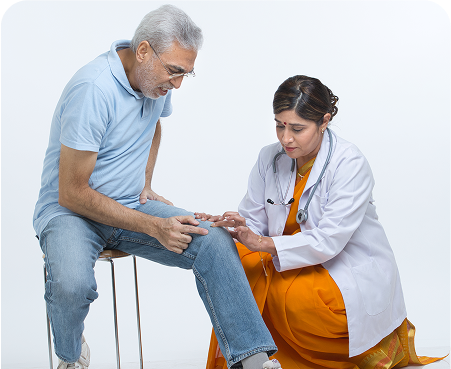
The right exercises can go a long way in a non surgical treatment plan. Our highly experienced physiotherapists help you get on the road to recovery with a plan that’s tailored to your pain diagnosis and your recovery goals.
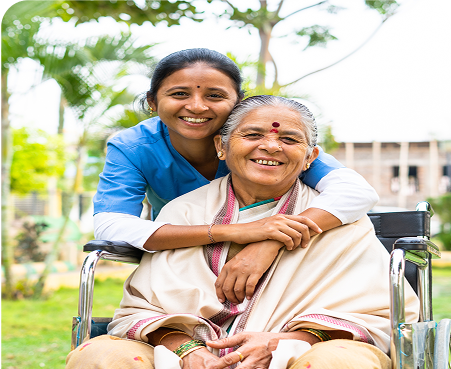
Our care manager is here to hold your hand through your journey of pain relief. They are here to coordinate all your medical interactions and guide you towards a pain-free life

We now understand that nutrition and pain are much more deeply connected than previously thought. Hence, we have world-class nutritionists who can help you eat right, create the right diet, and guide you towards a pain-free life.
If you’re ready to explore non-surgical treatments for back pain, Nivaan is here to help. Our holistic approach focuses on relieving pain, restoring function, and improving your quality of life.
Don’t let lower back pain limit your life. Contact Nivaan to schedule an appointment and take the first step toward finding lasting relief. We’re here to help you get back to doing the things you love.

Pioneering Interventional Pain Management
Delhi | Faridabad | Gurugram | Ghaziabad | Noida | Lucknow | Jaipur | Mumbai
© 2025 Nivaan. All Rights. Reserved